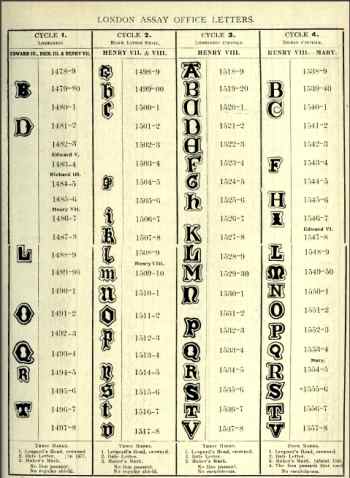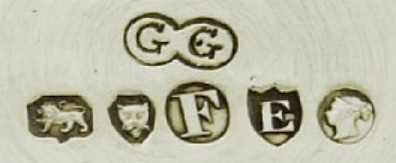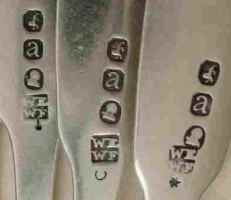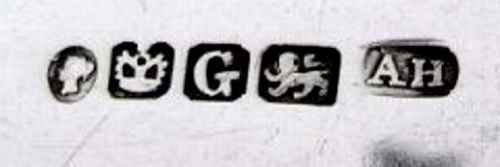|
|
HOW TO READ ENGLISH / BRITISH STERLING SILVER MARKS
THE UK SYSTEM OF HALLMARKS
From the end of the 12th century the craft of silversmith has been regulated in conformity with Royal Ordinances and Acts of the Parliament.
In England the craft was regulated by the Guild of Goldsmiths at London and in Ireland by the Guild of Dublin. In Scotland the craft was theoretically supervised by the Edinburgh Goldsmiths' Incorporation, but in practice its influence outside the capital was limited and a plethora di unofficial Scottish Provincial marks was created.
|
MARK OF ORIGIN - TOWN MARK
Identifies the Assay Office where the silver item was verified.
London origin is identified by the use of the leopard's head, crowned and uncrowned from 1821. In reality the leopard's head was a standard mark and its use applied to all goldsmiths throughout the land. It was not until 1856 that the leopard's head mark could have been used for any purpose other than a fineness mark.
Birmingham has the anchor, Chester the three wheat-sheaves and sword, Sheffield the crown and the Tudor rose (from 1975).
York has a five lions passant in a cross, Exeter a castle with three towers and Newcastle-upon-Tyne three castles.
In Scotland, Edinburgh has the castle and Glasgow the "tree, fish and bell".
In Ireland, Dublin origin is deduced by the presence of the figure of the crowned harp and Hibernia.
 |
 |
 |
 |
|
Londonleopard's head crowned (until 1820) |
London
leopard's head uncrowned (1821-present) |
London (1696-1719)
lion head erased |
Birmingham
anchor (1773-present) |
 |
 |
 |
 |
Birmingham
bicentennial commemorative (1973) |
Sheffield
crown (1773-1975) |
Sheffield
Tudor rose (1975-present) |
Chester
a sword erect between three wheat-sheaves (1784-1962) |
 |
 |
 |
 |
Exeter
a castle with three towers (1701-1856) |
Newcastle-upon-Tyne
three castles (c.1658-1883) |
York
five lions passant on a cross (c. 1710-1856) |
Edinburgh
castle (1483-present) |
 |
 |
 |
. |
Glasgow
tree, fish and bell (1681-1963) |
Dublin
crowned harp mark (until 1806) |
Dublin
Hibernia (1807-present) |
. |
STANDARD MARK
Since the 14th century the standard for silver in England was
set at 11 ounces and two pennyweights in the Troy pound (925 parts in 1000), it was related to money and as far as wrought
plate was concerned it had to be as good as money. The Statute 28 Ewd. Cap. XX which introduced this standard reads as follows:
"It is ordained, that no Goldsmith of England, nor none otherwhere within the King's Dominions, shall from henceforth.......
work worse silver than money".
The 925/1000 (sterling) silver fineness is certified in London and other British Assay Offices by the use of the "lion passant" mark.
For a short period (1696-1720) the standard was elevated to 958.4/1000 and the "Britannia" mark replaced the "lion passant".
Different standard marks are used in Scotland ("thistle" in Edinburgh and "lion rampant" in Glasgow and, later, Edinburgh) and in Ireland ("crowned harp" in Dublin).
 |
 |
 |
. |
|
lion passant (guardant) mark (London and other English Assay Offices) |
lion passant (facing left) mark (London and other English Assay Offices) |
Britannia mark
(1696-1719) |
. |
 |
 |
 |
. |
|
thistle mark (Edinburgh) |
lion rampant mark (Glasgow and Edinburgh from 1975) |
crowned harp mark (Dublin) |
. |
DATE LETTER
A date letter first appeared on English silver plate in the
year 1697 as a result of legislation. In clause VIII of the Act
8 & 9 William III c.8 which, among other things, deals with the
marks that must be applied to assayed plate at Goldsmiths' Hall
the following wording is used: " .... and a distinct variable
mark to be used by the warden of the said
mystery, to denote the year in which such plate is made;..." This legislation
remained in place until 1999 in which year the Government
adopted European hallmarking practice which does not require
that an assayed item of plate must be dated.
Series of alphabetical letters were chosen to indicate the year of assaying
(date letter) using "cycles of letters" of different font and size inside punches of various shapes.
Any Assay Office adopted its own cycle of date letters so that only from the 1975 the four surviving Assay Offices use a uniform system of dating (optional from 1999).
These are the links to the date letters tables of main Assay Offices:
London Birmingham
Sheffield
Chester Dublin
Edinburgh Glasgow

|
London Assay Office Letters, as illustrated in
"Hall Marks of Gold and Silver Plate",
by William
Chaffers, Tenth Edition, London 1922 |
MAKER'S MARK
In early times the maker's mark was constituted by a symbol but from the 15th century the mark
was formed by silversmith's name and surname initials.
Only for a short period (1696-1719) the maker's mark was formed with the first two letters of silversmith's surname.
Various fonts, sizes and outlines were adopted to differentiate the marks of silversmiths having the same initials.
LIST OF MAKER'S MARKS
ILLUSTRATED SELECTION OF MAKER'S MARKS
LIST OF NAMES
DUTY MARK
The Sovereign's Head demonstrates the payment of the duty on the piece bearing it. It was introduced in 1784 and lasted until 1890. In Glasgow the Sovereign's Head was introduced in 1819 while, from 1798, watchcases were exempted from the fee.
From July 15 1797, for nine months, the King's Head was duplicated owing to the Duty being doubled.
The "Duty Drawback" mark was used from December 1, 1784 to July 24, 1785 to claim back the duty when the item was exported.
A special duty mark (Hibernia) was used in Dublin from 1730 to 1806.
"Duty dodger" is the definition of unscrupulous silversmiths that used fraudulent methods to avoid paying the tax (e.g. inserting into a large piece a small disk bearing marks from an article on which a low tax had been paid).
 |
 |
 |
 |
 |
 |
 |
 |
1784 (LON) |
1787 (LON) |
1795 (LON) |
1797 (LON) |
1804 (LON) |
1812 (DUB) |
1818 (EDI) |
1818 (LON) |
 |
 |
 |
 |
 |
 |
 |
1822 (SHE) |
1823 (LON) |
1824 (BIR) |
1825 (DUB) |
1826 (LON) |
1829 (DUB) |
1832 (EDI) |
 |
 |
 |
 |
 |
 |
 |
 |
1833 (GLA) |
1835 (EDI) |
1835 (LON) |
1838 (LON) |
1854 (LON) |
1862 (BIR) |
1871 (LON) |
1871 (SHE) |
 |

 |
. |
King's Head duplicated
owing to the Duty being doubled |
"Duty Drawback" mark
for exported items |
. |
COMMEMORATIVE MARKS
Special temporary hallmarks are adopted to commemorate special events and anniversaries.
British Assay Offices used commemorative marks in 1935 (Silver Jubilee of King George V), 1953 (Coronation of Queen Elizabeth II), 1977 (Silver Jubilee of Queen Elizabeth II), 2000 (Millennium Mark), 2002 (Golden Jubilee of Queen Elizabeth II) and 2012 (Diamond Jubilee of Queen Elizabeth II).
 |
 |
 |
Silver Jubilee of
King George V |
Coronation of
Queen Elizabeth II |
Silver Jubilee of
Queen Elizabeth II |
 |
 |
 |
 |
|
Millennium Mark |
Golden Jubilee of
Queen Elizabeth II |
Diamond Jubilee of
Queen Elizabeth II |
Platinum Jubilee of
Queen Elizabeth II |
In 2023 a new commemorative mark has been designed to celebrate the coronation of His Majesty King Charles III. The King's Coronation Mark can be requested as a voluntary commemorative mark from 1 March 2023 and will be available until 31 December 2024. The mark depicts the King's head against an oval background.



|
IMPORT MARKS
The Custom Act of 1842 ordered that imported gold and silver couldn't be sold in Great Britain and Ireland unless it had been assayed at a British Office.
In 1867 the Foreign Mark was introduced adding an "F" to the appropriate British hallmark.

Foreign mark on London 1880 hallmark, importer Gustave Guilaudet |
In 1904 an Act of the Order of Council ordered that foreign silver had to be marked with the decimal value:
.925 for Sterling Standard and .958 for Britannia Standard.
A special Assay Office mark was introduced to be used in the addition to the annual date letter, while the "F" mark was omitted.
 |
 |
 |
 |
|
London1904-1906 |
London1906-1998(often upside down) |
Birmingham1904-1998 |
Chester1904-1962 |
 |
 |
 |
 |
|
Dublin1904-1906 |
Dublin1906-1998 |
Edinburgh1904-1998 |
Glasgow1904-1906 |
 |
 |
 |
. |
|
Glasgow1906-1964 |
Sheffield1904-1906 |
Sheffield1906-1998 |
. |
JOURNEYMAN MARK
WORKMAN MARK
The word journeyman comes from the French word journée, which means a period of one day.
It refers to the right the journeyman had to obtain a reward for each day's work.
In origin he was "a man who did not gain the freedom of the City and was therefore a 'non Freeman' but was free of a livery company and thus qualified to ply his trade could do so as a 'journeyman' provided he was licensed by the corporation. Often he would continue to work for his old master in the capacity of journeyman but he could, if he wished, go to another workshop and sometimes a silversmith would remain a journeyman for all of his working life" (courtesy David Mckinley/ASCAS).
The majority of silversmiths never actually registered their own mark. They were employed by large workshops of companies or were used as out-workers. The work they part or wholly produced was marked under somebody else's name.
These workers on plate were often paid on a pro rata basis, the foreman counting up their output each day so that they could be rewarded at the end of the week. The foreman also could distinguish between each of his workers' wares so that poor workmanship could be traced to the source. Thus a system was devised where each member of staff had his own punch (journeyman or workman mark), sometimes cut with the initials, but more often cut with a small symbol (a star, a leaf, a triangle, etc.) usually stamped next the maker's mark.






Examples of journeyman marks working for Chawner family |

Spoons dated 1816 made by different workmen in Eley & Fearn workshop |
CONTEMPORARY HALLMARKS
The British hallmarking system has been substantially modified in 1999.
Compulsory marks are the Assay Office mark, the sponsor's or maker's mark (at least two letters within a shield) and the Metal and fineness mark (purity in millesimal number).
The use of the traditional fineness mark (lion passant, lion rampant, Britannia) and date letter is maintained only on a voluntary basis.
HOW TO READ STERLING SILVER HALLMARKS
The marks of electroplated silver were often inspired to the hallmarking used for sterling
silver.
The purpose of these marks hid the unacknowledged goal of confusing the customer about the nature of the metal alloy.

silverplate

sterling silver |
The mark above is a trade mark on a mid-19th century silverplate piece manufactured by
Evans & Matthews of Birmingham, while the one below is on a sterling silver piece hallmarked by Sheffield Assay Office in 1850, maker
Martin Bros & Co.
These two marks are very similar: both have a "crown" and a set of alphabetical symbols to represent maker and date, but the fundamental difference is that the standard mark (lion passant) is missing on Evans & Matthews trademark as its use on metal different from sterling silver or on silver having silver fineness below 925/1000 is severely punished in the UK. Actually also the "crown" on silverplate was forbidden, but until 1895 c. its use was tolerated by Sheffield Assay Office.

(1) journeyman mark
(2) maker's mark (William Chawner)
(3) standard mark (lion passant 925/1000 purity)
(4) town mark (leopard's head London)
(5) date letter (1825)
(6) duty mark (sovereign head George IV)
|
I am indebted to David McKinley/ASCAS for many of the information contained in this page

www.silvercollection.it |
This is a page of 'The What is? Silver Dictionary' of A Small Collection of
Antique Silver and Objects of vertu, a 1500 pages richly illustrated website offering all you need to know about
antique silver, sterling silver, silverplate, Sheffield plate, electroplate silver,
silverware, flatware, tea services and tea complements, marks and hallmarks, articles,
books, auction catalogs, famous silversmiths (Tiffany, Gorham, Jensen, Elkington),
history, oddities ...
HOME - SITE MAP - SILVER DICTIONARY - COOKIES CONSENT AND PRIVACY |
| |















































































